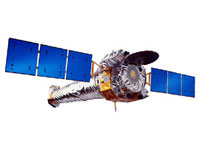August 29, 2002
CXC PR: 02-209

A black hole gobbles up matter in our own Milky Way Galaxy. A hot spot of X–rays pulsates from near Jupiter's poles. An intergalactic web of hot gas, hidden from view since the time galaxies formed, is finally revealed.
These scenarios sound like science fiction – but to those familiar with the latest developments in X–ray astronomy, they are just a few of the real–life discoveries made by NASA's Chandra X–ray Observatory during its third year of operation.
"Within the last year, Chandra has revealed another series of never–before–seen phenomena in our galaxy and beyond," said Chandra project scientist Dr. Martin Weisskopf of NASA's Marshall Space Flight Center in Huntsville, Ala.
"When you combine recent discoveries with the secrets revealed during the observatory's first two years in orbit, it's amazing how much Chandra has told us about the universe in a relatively short period of time."
One such discovery was an unprecedented view of a supermassive black hole devouring material in the Milky Way Galaxy – a spectacle witnessed for the first time when Chandra observed a rapid X–ray flare emitted from the direction of the black hole residing at our galaxy's center.
In a just few minutes, Sagittarius A, a source of radio emission believed to be associated with the black hole, became 45 times brighter in X–rays, before declining to pre–flare levels a few hours later, offering astronomers a never–before–seen view of the energetic processes surrounding this supermassive black hole.
"When we launched the Chandra Observatory, we attempted to explain its amazing capabilities in Earthly terms, such as the fact it can 'see' so well, it's like someone reading the letters of a stop sign 12 miles away," said Chandra Program Manager Tony Lavoie of the Marshall Center.
"But now that the observatory has been in orbit for three years, we have unearthly proof of the technological marvel Chandra really is. Not only has it continued to operate smoothly and efficiently, it has provided the highest quality X–ray images ever made. Now, we're not talking about stop signs, but rather black holes, star systems, galaxies and planets."
One such discovery involved the planet Jupiter. Using the Chandra Observatory, astronomers discovered a pulsating hot spot of X–rays in the polar regions of the planet's upper atmosphere and uncovered evidence the X–ray source is not arising from the region of Jupiter where previously believed.
By revealing that most of the X–rays come from a hot spot appearing at a fixed location near Jupiter's north magnetic pole, Chandra disproved the previous model, which placed the emission at a lower latitude of the planet's atmosphere and had no knowledge the X–rays were pulsed.
"Sometimes new discoveries provide answers, and sometimes they pose more questions," said Weisskopf. "This is a good example, because by pinpointing the location of Jupiter's hot spot, Chandra ruled out the existing explanation for the planet's X–ray emission. Now we must search for a new process that explains Jupiter's X–rays. When we accomplish that, we can assemble yet another piece to the cosmic puzzle."
One such piece fell into place when the Chandra Observatory discovered part of an intergalactic web of hot gas and dark matter that contains most of the material in the universe. The hot gas, which appeared to lie like a fog in channels carved by rivers of gravity, has been hidden from view since the time galaxies formed.
These observations, together with ultraviolet observations, helped shed new light on how the universe evolved. The hot gas detected by Chandra can be used to trace the presence of the more massive dark matter component. The discovery of the hot gas may eventually enable astronomers to map the distribution of dark matter in the universe and perhaps understand its origin.
These recent discoveries build on a series of groundbreaking findings made by the Chandra Observatory during its first two years of operation. Initial highlights include its discovery of an X–ray ring around the Crab Nebula , finding the most distant X–ray cluster of galaxies, capturing the deepest X–ray images ever recorded and discovering a new size of black hole.
Because Earth's atmosphere blocks X–rays from reaching the surface, X–ray astronomy can only be performed from space. Launched in July 1999, the Chandra Observatory travels one–third of the way to the Moon during its orbit around the Earth every 64 hours. At its highest point, Chandra's highly elliptical, or egg–shaped, orbit is 200 times higher than that of its visible–light–gathering sister, the Hubble Space Telescope.
The Marshall Center manages the Chandra program, and TRW, Inc. of Redondo Beach, Calif., is the prime contractor for the spacecraft. The Smithsonian Astrophysical Observatory's Chandra X–ray Center controls science and flight operations from Cambridge, Mass.
MEDIA CONTACTS
Steve Roy
Marshall Space Flight Center, Huntsville, AL
Phone: 256-544-6535


